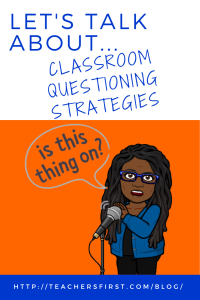We know that asking questions is one of the most powerful ways to engage students, check for understanding, and deepen learning. But can we also use questioning strategies to change the culture of our classrooms? How can we help students to begin asking and exploring their own questions? In this post, we’ll explore how to use questioning strategies to scaffold cultural shifts in our classrooms. Let’s get started!
Fostering Curiosity and Inquiry
One of the goals of using questions in the classroom is to spark students’ curiosity and interest in our content and the world. We want students to wonder, ask questions, and seek answers. To foster a culture of curiosity and inquiry, we can:
- Model curiosity by asking genuine questions that show our own interest and enthusiasm for the topic. For example, “I wonder why Veterans Day was created?” or “What do you think people should do on Veterans Day?” or “How does Veterans Day relate to what we learned about citizenship?”
- Encourage student-generated questions by providing opportunities for students to ask their own questions about the content, the process, or the product of learning. For example, we can use tools like EverFi (reviewed here) or Checkology (reviewed here) to help students develop critical thinking and media literacy skills by asking questions about the sources, evidence, and perspectives they encounter online.
- Support student inquiry by helping students explore their questions using various methods and resources. For example, we can use choice boards or Multimedia Text Sets to offer students different ways to investigate a topic, such as reading articles, watching videos, conducting experiments, or interviewing experts.
Promoting Respect and Dialogue
A second goal of using questions in the classroom is to facilitate communication and collaboration. It’s important that students learn to listen to and learn from each other’s perspectives and experiences. To promote a culture of respect and dialogue, we can:
- Establish norms for respectful and productive discussions. For example, we can set expectations for how students will talk to each other, such as using respectful language, taking turns, building on each other’s ideas, and disagreeing politely.
- Use open-ended questions that invite multiple viewpoints and interpretations. For example, we can ask questions that start with “How do you…?”, “What do you think…?”, “Why do you agree/disagree…?”, or “What evidence do you have…?”
- Facilitate dialogue by providing structures and strategies that promote student interaction and exchange. For example, using accountable talk frames during class discussions. We can also use protocols like Think-Pair-Share, Fishbowl, or Socratic Seminar to organize how students talk to each other in pairs, small groups, or the whole class.
Building a Culture of Trust and Feedback
A third goal of questioning is to provide feedback and guidance to students. We want students to receive constructive and timely feedback from others, and also learn to self-assess and reflect on their own learning. To build a culture of trust and feedback, we can:
- Use formative assessment to monitor student progress and adjust instruction accordingly. For example, we can use tools like Kahoot! (reviewed here) or Quizizz (reviewed here) to create engaging quizzes that check for understanding and provide immediate feedback.
- Use descriptive feedback that focuses on the strengths and areas for improvement of student work. For example, we can use the RISE model, rubrics, or success criteria to communicate the expectations and criteria for quality work, and provide specific comments that highlight what students did well and what they need to work on.
- Use self-assessment and reflection to help students evaluate their own learning and set goals for improvement. For example, we can use tools like Microsoft Forms (reviewed here) or Sway (reviewed here) to create surveys or portfolios that prompt students to rate their performance, identify their challenges, and plan their next steps.
Developing a Culture of Challenge and Growth
A fourth goal is to challenge students and support their growth. Students should be exposed to different levels and types of questions that stretch their thinking and skills. They also need to learn to cope with uncertainty and ambiguity. To develop a culture of challenge and growth, we can:
- Use higher-order questions that require students to analyze, synthesize, evaluate, or create. For example, we can use Bloom’s Taxonomy or Webb’s Depth of Knowledge as frameworks to design questions that move beyond recall or comprehension.
- Use divergent questions that have more than one possible answer or solution. For example, we can use questions that start with “What if…?”, “How might…?”, “How many ways…?”, or “What are some alternatives…?”
- Use metacognitive questions that help students think about their own thinking and learning processes. For example, we can use questions like “How did you solve this problem?” or “What strategies did you use?” or “How do you know this is correct?” or “What did you learn from this?”
I hope this post has given you some ideas and inspiration on ways to use questioning strategies in your classroom. I’d love to hear from you: What are some of the questioning strategies you use or want to try? How do you create a culture of curiosity, respect, feedback, and challenge in your classroom? Please share your thoughts and experiences in the comments below.


